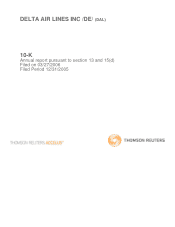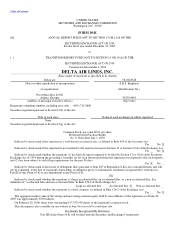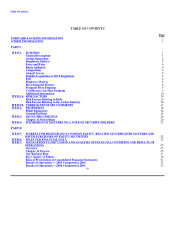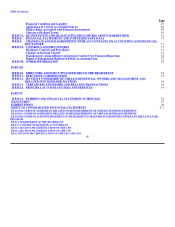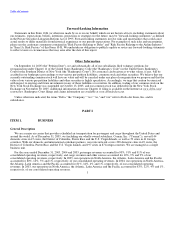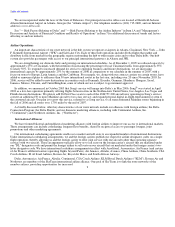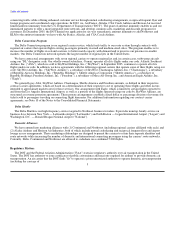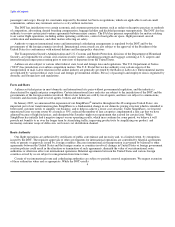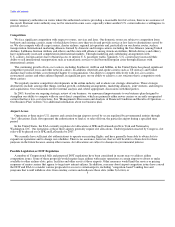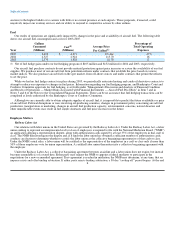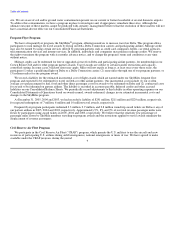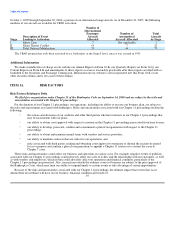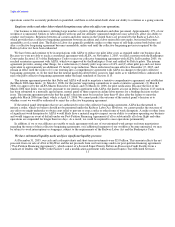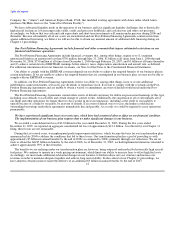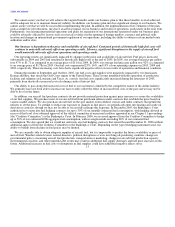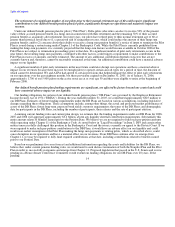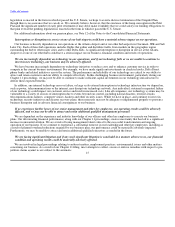Delta Airlines 2005 Annual Report Download - page 10
Download and view the complete annual report
Please find page 10 of the 2005 Delta Airlines annual report below. You can navigate through the pages in the report by either clicking on the pages listed below, or by using the keyword search tool below to find specific information within the annual report.
Table of Contents
renews temporary authorities on routes where the authorized carrier is providing a reasonable level of service, there is no assurance of
this result. Dormant route authority may not be renewed in some cases, especially where another U.S. carrier indicates a willingness to
provide service.
Competition
We face significant competition with respect to routes, services and fares. Our domestic routes are subject to competition from
both new and existing carriers, many of which have lower costs than we do and provide service at low fares to destinations served by
us. We also compete with all-cargo carriers, charter airlines, regional jet operators and, particularly on our shorter routes, surface
transportation. International marketing alliances formed by domestic and foreign carriers, including the Star Alliance (among United
Airlines, Lufthansa German Airlines and others) and the oneworld alliance (among American Airlines, British Airways and others),
have significantly increased competition in international markets. Through marketing and codesharing arrangements with
U.S. carriers, foreign carriers have obtained access to interior U.S. passenger traffic. Similarly, U.S. carriers have increased their
ability to sell international transportation such as transatlantic services to and beyond European cities through alliances with
international carriers.
The continuing growth of low-cost carriers, including Southwest, AirTran and JetBlue, in the United States has placed significant
competitive pressure on us and other network carriers. In addition, other hub-and-spoke carriers such as US Airways and United
Airlines have reduced their costs through Chapter 11 reorganization. Our ability to compete effectively with low-cost carriers,
restructured carriers and other airlines depends, in significant part, on our ability to achieve a cost structure that is competitive with
those carriers.
We regularly monitor competitive developments in the airline industry and evaluate our strategic alternatives. These strategic
alternatives include, among other things, internal growth, codesharing arrangements, marketing alliances, joint ventures, and mergers
and acquisitions. Our evaluations involve internal analysis and, where appropriate, discussions with third parties.
In 2005, based on our ongoing strategic review of our business, we announced improvements to our business plan designed to
strengthen our ability to compete with our most direct competitors, which are primarily either newer carriers or recently reorganized
carriers that have low-cost structures. See "Management's Discussion and Analysis of Financial Condition and Results of Operation —
Our Business Plan" in Item 7 for additional information about our business plan.
Airport Access
Operations at three major U.S. airports and certain foreign airports served by us are regulated by governmental entities through
"slot" allocations. Each slot represents the authorization to land at, or take off from, the particular airport during a specified time
period.
In the United States, the FAA currently regulates slot allocations at JFK and LaGuardia in New York and National in
Washington, D.C. Our operations at those three airports generally require slot allocations. Under legislation enacted by Congress, slot
rules will be phased out at JFK and LaGuardia by 2007.
We currently have sufficient slot authorizations to operate our existing flights, and have generally been able to obtain slots to
expand our operations and to change our schedules. There is no assurance, however, that we will be able to obtain slots for these
purposes in the future because, among other reasons, slot allocations are subject to changes in governmental policies.
Possible Legislation or DOT Regulation
A number of Congressional bills and proposed DOT regulations have been considered in recent years to address airline
competition issues. Some of these proposals would require large airlines with major operations at certain airports to divest or make
available to other airlines slots, gates, facilities and other assets at those airports. Other measures would limit the service or pricing
responses of major carriers that appear to target new entrant airlines. In addition, concerns about airport congestion issues have caused
the DOT and FAA to consider various proposals for access to certain airports, including "congestion-based" landing fees and
programs that would withdraw slots from existing carriers and reallocate those slots (either by lottery or
5

